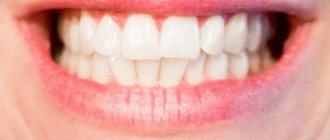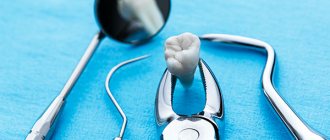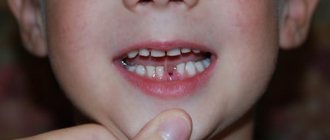The organic and inorganic tissues that make up the tooth form a close relationship. Hard tissues (tooth cement, dentin, enamel) belong to the inorganic part, but the pulp is a living, organic connective tissue, with the help of which the tooth is “nourished” from the inside. It is a bundle of nerves and blood vessels and is located in the pulp chamber of the tooth. Preserving the viability of the organic component is very important, because its death due to injury and infection leads to the appearance of a “dead tooth” in the oral cavity.
What to do with a dead baby tooth?
If you notice a change in the color of one of your child's baby teeth, the tooth may be dying. There is usually no need for treatment as they will fall out anyway. However, you should monitor the tooth for signs of infection and take your child to the pediatric dentist for a checkup . The dentist may take x-rays to determine if there are underlying problems that are causing concern.
Results
Dead tooth is the general name for a condition in which the inside of a tooth is filled with dead tissue or special materials after root canal treatment. If all pulp cells are necrotic, the patient does not feel pain. Due to the potential for serious complications, a dead tooth should be treated. Most often, root canal treatment is performed, and in case of contraindications, a fragment or the entire tooth is removed. The most common cause of a dead tooth is decaying bacteria, so good oral hygiene and regular dental checkups are the foundation of a healthy smile.
Treatment of a dead tooth
Your dentist has a choice and knows how to treat a dead tooth. He may take x-rays to determine the best course of action, but you can expect one of two results.
- Extraction or removal of a tooth with the installation of a bridge or implant in its place.
- Root canals can save a tooth. However, multiple procedures may be required to save a tooth, and a crown may be needed to support a weakened tooth.
How to save a dying tooth naturally
Dentists prefer to preserve natural teeth whenever possible because nothing looks or feels quite like them. Tooth extraction can affect your ability to speak and eat, and can also affect your smile, especially if you have a dead front tooth. This is why root canals remain the preferred treatment for a dying or dead tooth, and you should advocate for this option.
Avoiding tooth extraction is extremely important and is a huge reason to visit your dentist regularly for checkups . They may notice signs of a dying tooth early during an examination or on x-rays. The sooner you notice this, the better the result will be.
Professional whitening of pulpless teeth
Whitening a dead tooth in a dental office is a completely safe and most effective procedure. One of the popular methods of professional lightening is endobleaching. The procedure is carried out in the following order:
- First, the dentist removes the old filling from the pulped tooth;
- then a special bleaching agent is introduced into its internal cavity. In most cases this is sodium perbonate, if necessary a small amount of hydrogen peroxide is added to it;
- After this, the doctor installs a temporary filling. If it is necessary to re-inject the brightening reagent, the filling is removed again. The number of procedures depends on the degree of darkening of the tooth;
- Once the desired color is achieved, a permanent filling is placed on the tooth.
In addition to intracanal bleaching, the dentist may also suggest other methods, for example, the use of veneers or crowns.
There is a question: why does a tooth hurt if the nerve is removed?
Dentistry / Media about us / There is a question: why does a tooth hurt if the nerve is removed?
My name is Gogia Tea Zurabovna, I am a dentist-therapist at the SCNT “NOVOSTOM”. Many patients asked me the same question, so I decided to talk about it in detail.
Most people believe that if you remove the nerve from a tooth, it will never hurt again. What can hurt if the nerve is removed?
As soon as the patient catches a cold or simply freezes, such teeth begin to make themselves felt. Patients are surprised to learn at a dentist's appointment that the anxiety is caused by inflammation at the root of the tooth, and they need a new root canal treatment.
“I’ve already been treated for them!” they say: “What can hurt there if the nerve is removed? Without a nerve, a tooth is dead!” This is the most common misconception among patients, which leads to forced re-treatment.
It is important to know that if a tooth has been depulped, or, as we used to say, the nerve has been removed from it, this does not mean that this tooth will never hurt.
Pulpless teeth also need to be observed. There is a situation when, several years after removal of the nerve and treatment, inflammation may occur at the top of the tooth and treatment of periodontitis is necessary. It may not bother the patient, and he will not suspect it until an image is taken at a dentist’s appointment.
Or until, due to a decrease in immunity caused by a simple seasonal viral disease, the root inflammation worsens and the tooth becomes painful, causing trouble for the patient.
There can be several reasons for periodontitis:
- The main reason for the development may be poor-quality treatment of canals in the tooth: all root canals must be well processed and tightly sealed over the entire length. If the dentist missed the canal, did not remove the remains of the instrument, or allowed perforation of the canal, then this may subsequently cause an inflammatory process and root canal treatment will be required.
- However, periodontitis often develops with well-treated canals due to a large load, the so-called overload, on the tooth, caused by the anatomical features of the patient’s bite, when, due to injury, cracks, an allergic reaction to medications and toxins, the tightness of the tooth is broken and infection occurs.
Most often, microorganisms begin to multiply in the area of the root apex at the junction of bone and soft tissue. They release toxins, which leads to bone defects
, surrounding the tooth. This is exactly the case shown in the picture (Fig. 1 and Fig. 2).
It is for this reason that dentists recommend examining your teeth six months after treatment, and then taking an x-ray at least once a year for diagnostic purposes. It is important to know that at a certain frequency, which depends on the individual characteristics of the patient, and which should be checked with the treating dentist, it is necessary to take not only a targeted photograph and a panoramic photograph of the tooth of the previously treated tooth.
On OPTG Lower 3.6 teeth.
Spot shot of 3.6 teeth
For a more accurate diagnosis, it is also necessary to periodically do cone beam computed tomography (CBCT), which is usually abbreviated as CT. This technique improves the quality of diagnosis, often allowing you to avoid many errors in the process of treatment and diagnosis, and will not allow you to miss the moment of necessary treatment.
When conducting a study using CT, we get a 3D image that allows us to better study the condition of the patient’s jaws, viewing them on the screen in different projections. Thanks to dental CT, you can see each tooth not only from the front, but also from below, above, from the side, while rotating it at any angle.
Often, an inflammatory focus may not be visible on a targeted or panoramic photograph of a tooth: these are two-dimensional photographs, and the inflammatory focus may be covered by the tooth root or other structures.
The CT scan shows the same tooth as in the targeted image and in the OPTG.
Re-treatment of a tooth is especially difficult. No one can guarantee a 100% positive result during retreatment, since even with strict adherence to all treatment rules, the canal cannot be completely rid of microbes that have entered it. A lot depends on the patient’s body and its immunity.
Treatment methods used in modern dentistry help us to significantly reduce the likelihood of periodontitis: tooth isolation using a rubber dam, dental treatment under a microscope to process and study the anatomy of the tooth, good and high-quality medicinal and mechanical treatment of root canals.
By paying attention to all these points when choosing a clinic and a doctor, and not forgetting that the most important thing for your teeth is regular observation and good hygiene, you can make your visits to the dentist painless and enjoyable.
Source
Nerve function and reasons for its removal
Dental nerve endings perform several functions: they respond to external stimuli (cold, hot, spicy, sour) and protect elements from pathogenic microorganisms. It is believed that teeth lacking pulp are more vulnerable to caries and other destructive processes.
Often, elements devoid of nerves may also differ in shade from healthy teeth, since they tend to darken. Because of this, the pulpless elements are called “dead” in another way. This process is due to the fact that the tooth is deprived of blood supply and does not receive the necessary minerals from the body.
It is worth considering in more detail the situations in which dentists recommend resorting to tearing out the tooth pulp and subsequently filling it with composite materials. In mild forms of caries, only the upper part of the tooth – enamel and dentin – is affected. In this case, doctors remove the damaged layers of the tooth without affecting its nerve endings. In advanced forms of the disease, the nerve endings of the tooth (pulp) may be damaged; in this case, dentists remove the tissue completely or only part of it.
The indication for depulpation is periodontitis. In this case, it is impossible to restore the health of the tooth without removing the nerve endings in it. Inflammation of the pulp is also possible if the dentist did not properly clean the dentinal tubules of the tooth or made mistakes when filling it. This type of problem in dentistry is called “drug-induced pulpitis.”
Other indications for depulpation include:
- extensive tooth destruction (more than 2/3 of the crown);
- prolonged aching pain in the element;
- the presence of stones in the root canals of the tooth;
- chipping or damage to the bone tissue of the elements as a result of consumption of hard foods or any trauma.
Nerve endings can also be removed in those elements that appear healthy. Pathological processes do not always begin in the visible part; in some cases, caries and inflammatory processes are localized in the deep layers, under the crown.
When does a tooth die?
The question of when a tooth dies and what it entails naturally worries many. “When caries has destroyed the crown part of the tooth deeply, then bacteria penetrate the pulp, infect it, and inflammation begins, and then rotting of the pulp,” notes the dentist. This is the beginning of the end for the tooth. “To prevent inflammation from spreading to surrounding tissues, the doctor cleans the tooth and its roots from the inside with special instruments and medications, and then fills the resulting voids with special filling materials,” notes Ilya Antonov. Next, a filling or crown is placed on top of the tooth: the doctor decides on the optimal covering based on the degree of tooth decay. Such a tooth becomes “dead”.
Previously, as the dentist notes, such teeth were immediately removed. Today the approach has changed somewhat. “It can be depulped and left in the mouth,” the dentist emphasizes. In this case, the tooth naturally loses its strength, says Ilya Antonov.
At the same time, of course, a tooth cannot be called completely lifeless, as Ilya Antonov says. “We must also take into account the fact that the tooth is surrounded on the outside by a ligamentous apparatus, which is connected on one side to the bone, and on the other side to the root of the tooth. You can imagine this as a kind of flagella between the root and the bone. There are many of them, and among them there are also blood vessels and nerve endings, which continue to partially nourish the tooth. So he cannot be called completely dead. But it’s also impossible to revive it; you can’t put the pulp back,” says Ilya Antonov.
They wanted to know, but were embarrassed to ask. 10 questions for a dentist Read more











